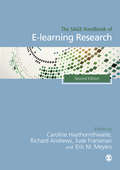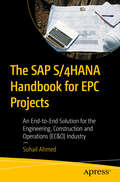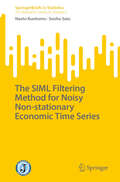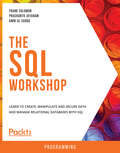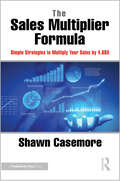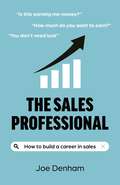- Table View
- List View
The SAGE Handbook of Digital Marketing
by Annmarie Hanlon Tracy L. TutenDigital marketing changes the dynamics of traditional routes to market, augments conversations and facilitates the measurement of activities by organisations and consumers alike. This Handbook strives to advance the study and understanding of this domain and provides a digital marketing journey that flows from methods and methodologies. It moves from the fundamentals to the different aspects of digital marketing strategy, tactics, metrics and management, and ethics. This Handbook brings together the critical factors in digital marketing as the essential reference set for researchers in this area of continued growth. It is essential reading for postgraduate students, researchers, and practitioners in a range of disciplines exploring digital marketing. Part 1: Foundations of Digital Marketing Part 2: Methodologies and Theories in Digital Marketing Part 3: Channels and Platforms in Digital Marketing Part 4: Tools, Tactics and Techniques in Digital Marketing Part 5: Management and Metrics in Digital Marketing Part 6: Ethical Issues in Digital Marketing
The SAGE Handbook of Digital Marketing
by Annmarie Hanlon Tracy L. TutenDigital marketing changes the dynamics of traditional routes to market, augments conversations and facilitates the measurement of activities by organisations and consumers alike. This Handbook strives to advance the study and understanding of this domain and provides a digital marketing journey that flows from methods and methodologies. It moves from the fundamentals to the different aspects of digital marketing strategy, tactics, metrics and management, and ethics. This Handbook brings together the critical factors in digital marketing as the essential reference set for researchers in this area of continued growth. It is essential reading for postgraduate students, researchers, and practitioners in a range of disciplines exploring digital marketing. Part 1: Foundations of Digital Marketing Part 2: Methodologies and Theories in Digital Marketing Part 3: Channels and Platforms in Digital Marketing Part 4: Tools, Tactics and Techniques in Digital Marketing Part 5: Management and Metrics in Digital Marketing Part 6: Ethical Issues in Digital Marketing
The SAGE Handbook of E-learning Research
by Eric M. Meyers Jude Fransman Professor Caroline Haythornthwaite Mr Richard N. L. AndrewsThe new edition of The SAGE Handbook of E-Learning Research retains the original effort of the first edition by focusing on research while capturing the leading edge of e-learning development and practice. Chapters focus on areas of development in e-learning technology, theory, practice, pedagogy and method of analysis. Covering the full extent of e-learning can be a challenge as developments and new features appear daily. The editors of this book meet this challenge by including contributions from leading researchers in areas that have gained a sufficient critical mass to provide reliable results and practices. The 25 chapters are organised into six key areas: 1. THEORY 2. LITERACY & LEARNING 3. METHODS & PERSPECTIVES 4. PEDAGOGY & PRACTICE 5. BEYOND THE CLASSROOM 6. FUTURES
The SAGE Handbook of E-learning Research, 2e
by Eric M. Meyers Richard Andrews Jude Fransman Professor Caroline HaythornthwaiteThe new edition of The SAGE Handbook of E-Learning Research retains the original effort of the first edition by focusing on research while capturing the leading edge of e-learning development and practice. Chapters focus on areas of development in e-learning technology, theory, practice, pedagogy and method of analysis. Covering the full extent of e-learning can be a challenge as developments and new features appear daily. The editors of this book meet this challenge by including contributions from leading researchers in areas that have gained a sufficient critical mass to provide reliable results and practices. The 25 chapters are organised into six key areas: 1. THEORY 2. LITERACY & LEARNING 3. METHODS & PERSPECTIVES 4. PEDAGOGY & PRACTICE 5. BEYOND THE CLASSROOM 6. FUTURES
The SAGE Handbook of Human–Machine Communication
by Steve Jones Rhonda McEwen Andrea L. GuzmanThe SAGE Handbook of Human-Machine Communication has been designed to serve as the touchstone text for researchers and scholars engaging in new research in this fast-developing field. Chapters provide a comprehensive grounding of the history, methods, debates and theories that contribute to the study of human-machine communication. Further to this, the Handbook provides a point of departure for theorizing interactions between people and technologies that are functioning in the role of communicators, and for considering the theoretical and methodological implications of machines performing traditionally ‘human’ roles. This makes the Handbook the first of its kind, and a valuable resource for students and scholars across areas such as communication, media and information studies, and computer science, as well as for practitioners, engineers and researchers interested in the foundational elements of this emerging field. Part 1: Histories and Trajectories Part 2: Approaches and Methods Part 3: Concepts and Contexts Part 4: Technologies and Applications
The SAGE Handbook of Human–Machine Communication
by Steve Jones Rhonda McEwen Andrea L. GuzmanThe SAGE Handbook of Human-Machine Communication has been designed to serve as the touchstone text for researchers and scholars engaging in new research in this fast-developing field. Chapters provide a comprehensive grounding of the history, methods, debates and theories that contribute to the study of human-machine communication. Further to this, the Handbook provides a point of departure for theorizing interactions between people and technologies that are functioning in the role of communicators, and for considering the theoretical and methodological implications of machines performing traditionally ‘human’ roles. This makes the Handbook the first of its kind, and a valuable resource for students and scholars across areas such as communication, media and information studies, and computer science, as well as for practitioners, engineers and researchers interested in the foundational elements of this emerging field. Part 1: Histories and Trajectories Part 2: Approaches and Methods Part 3: Concepts and Contexts Part 4: Technologies and Applications
The SAGE Handbook of Social Media Marketing
by Annmarie Hanlon Tracy L. TutenSocial media marketing has become indispensable for marketers who utilize social media to achieve marketing objectives ranging from customer care to advertising to commerce. This Handbook explores the foundations and methodologies in analysing the important aspects of social media for organisations and consumers. It investigates critical areas concerning communities, culture, communication and content, and considers social media sales. This Handbook brings together the critical factors in social media marketing as the essential reference set for researchers in this area of continued growth. It is essential reading for postgraduate students, researchers, and practitioners in a range of disciplines exploring the area. Part 1: Foundations of Social Media Marketing Part 2: Methodologies and Theories in Social Media Part 3: Channels and Platforms in Social Media Part 4: Tools, Tactics, and Techniques in Social Media Marketing Part 5: Management and Metrics in Social Media Part 6: Ethical Issues in Social Media
The SAGE Handbook of Social Media Marketing
by Annmarie Hanlon Tracy L. TutenSocial media marketing has become indispensable for marketers who utilize social media to achieve marketing objectives ranging from customer care to advertising to commerce. This Handbook explores the foundations and methodologies in analysing the important aspects of social media for organisations and consumers. It investigates critical areas concerning communities, culture, communication and content, and considers social media sales. This Handbook brings together the critical factors in social media marketing as the essential reference set for researchers in this area of continued growth. It is essential reading for postgraduate students, researchers, and practitioners in a range of disciplines exploring the area. Part 1: Foundations of Social Media Marketing Part 2: Methodologies and Theories in Social Media Part 3: Channels and Platforms in Social Media Part 4: Tools, Tactics, and Techniques in Social Media Marketing Part 5: Management and Metrics in Social Media Part 6: Ethical Issues in Social Media
The SAGE Handbook of Web History
by Ian Milligan Niels BrüggerThe Web has been with us now for almost 25 years. An integral part of our social, cultural and political lives, ‘new media’ is simply not that new anymore. Despite the rapidly expanding archives of information at our disposal, and the recent growth of interest in web history as a field of research, the information available to us still far outstrips our understanding of how to interpret it. The SAGE Handbook of Web History marks the first comprehensive review of this subject to date. Its editors emphasise two main different forms of study: the use of the web as an historical resource, and the web as an object of study in its own right. Bringing together all the existing knowledge of the field, with an interdisciplinary focus and an international scope, this is an incomparable resource for researchers and students alike. Part One: The Web and Historiography Part Two: Theoretical and Methodological Reflections Part Three: Technical and Structural Dimensions of Web History Part Four: Platforms on the Web Part Five: Web History and Users, some Case Studies Part Six: The Roads Ahead
The SAP Fiori Handbook: A Step-By-Step Guide to SAP Fiori Essentials
by Manpreet S. Brara Subba Rao ParvathaneniThe SAP Fiori Handbook is your one-stop-shop to turbo charge your UX skills to ensure your enterprise applications are more user-friendly and accessible. This handbook is broadly divided into four sections and provides you with an in-depth exploration of the SAP Fiori system with chapters offering a theoretical context as well as detailed, step-by-step explanations of the key concepts providing you with a systematic approach to deepen your understanding of the SAP Fiori environment. The book will cover everything from introductory concepts and installation before moving through the key elements of the SAP Fiori system, from the Fiori App, Launchpad Content Manager and SAP Fiori UI. We will also cover important topics like app support and troubleshooting and diving into SAP Fiori Reports too. You Will: Explore the entire SAP Fiori eco-system Learn to configure and manage SAP Fiori Launchpad content See how to create custom apps and technical catalogs Explore how to implement Spaces and Pages Understand how to use App Support Functionality for troubleshooting Explore how to configure and manage Catalogs and Groups using SAP Fiori Launchpad Designer Understand how to convert existing Groups to Pages Get to grips with Fiori Apps recommendation report as well as SAP Fiori Upgrade Impact Analysis Report Who is this Book for: SAP Fiori administrators, consultants and Business Analysts as well as anyone responsible for configuring and maintaining the SAP Fiori launchpad experience for their company.
The SAP Materials Management Handbook
by Ashfaque AhmedAlthough tens of thousands of global users have implemented Systems, Applications, and Products (SAP) for enterprise data processing for decades, there has been a need for a dependable reference on the subject, particularly for SAP materials management (SAP MM).Filling this need, The SAP Materials Management Handbook provides a complete understandi
The SAP S/4HANA Handbook for EPC Projects: An End-to-End Solution for the Engineering, Construction and Operations (EC&O) Industry
by Sohail AhmedThe SAP S/4HANA Handbook for EPC Projects equips you with the knowledge and insights needed to successfully manage and execute complex Engineering, Procurement, and Construction (EPC) projects using the power of SAP S/4HANA. Building upon your existing knowledge of SAP solutions, this handbook provides advanced insights into EPC project management and addresses the operational challenges unique to the Engineering, Construction and Operations (EC&O) industry by connecting business processes with relevant SAP solutions. It is an essential guide enabling you to gain a deeper understanding of optimizing your project management capabilities using SAP S/4HANA. Whether you are an SAP Solution Architect in Finance, Human Resources, or Supply Chain Management, or a project manager in the EC&O industry, this book will help you understand how projects can be managed with SAP. We begin by examining the world of EPC, EPC/M (Engineering, Procurement, Construction, and Management), and ETO (Engineer-To-Order) projects.Looking at detailed planning, controlling, and execution solutions of EPC projects with S/4HANA Project System, CPM (Commercial Project Management), PPM (Project & Portfolio Management), S/4HANA Add-ons, SAP Cloud Solutions, and to integrate these with other engineering and project management software such as Tekla and Primavera through SAP BTP (Business Technology Platform). You will follow a construction company secure an EPC contract of a refinery upgrade project and demonstrates how SAP is used at every step of the way, from bidding to project closure. Through real-world use-cases, supported by tables and visual aids, you will find the practical solutions offered by SAP S/4HANA. The SAP S/4HANA Handbook for EPC Projects is the ultimate resource bridging theory with practical applications, offering a framework to navigate the complexities of modern project management in the EC&O industry. You Will Learn To: Understand project management processes with business use cases and their application in SAP Apply detailed planning, scheduling, resource and management strategies, as well as for risk and claim managmement in large-scale projects. <span style="font-size: 11.0pt !msorm; font-family: 'Calibri',sans-serif !msorm; mso-ascii-theme-font: minor-latin !msorm; mso-hansi-th
The SEO Battlefield: Winning Strategies for Search Marketing Programs
by Anne Ahola WardWelcome to the battlefield. Every day, companies ranging from startups to enterprises fight to achieve high search rankings, knowing that previous success can quickly vanish. With this practical guide, you’ll learn how to put search engine optimization (SEO) methodology into practice, including the research, data analysis, and constant experimentation required to build an SEO program specific to your organization that can help you improve search results.Running a successful SEO program requires a team with a mix of skills, including marketing, analytics, website development, and automation. Author Anne Ahola Ward walks marketers and developers through SEO essentials and provides real-world case studies of successful and not-so-successful SEO programs. You’ll quickly understand why this is both an exciting and critical time to adopt SEO in your organization.Perform keyword goals and research, and spot search trendsUnderstand the motivation and creativity of the SEO mindsetRun a campaign to generate traffic and measure the resultsUse mobile and platform-agnostic strategies for search growthDemonstrate the value of your search marketing effortsInclude web development in your SEO program—everything from quick updates to UX/UI strategyLearn the sweetest way to run and report on an search program
The SIM Guide to Enterprise Architecture
by Leon KappelmanEnterprise architecture is leading IT's way to the executive boardroom, as CIOs are now taking their place at the management table. Organizations investing their time, money, and talent in enterprise architecture (EA) have realized significant process improvement and competitive advantage. However, as these organizations discovered, it is one thing
The SIML Filtering Method for Noisy Non-stationary Economic Time Series (SpringerBriefs in Statistics)
by Naoto Kunitomo Seisho SatoIn this book, we explain the development of a new filtering method to estimate the hidden states of random variables for multiple non-stationary time series data. This method is particularly helpful in analyzing small-sample non-stationary macro-economic time series. The method is based on the frequency-domain application of the separating information maximum likelihood (SIML) method, which was proposed by Kunitomo, Sato, and Kurisu (Springer, 2018) for financial high-frequency time series. We solve the filtering problem of hidden random variables of trend-cycle, seasonal, and measurement-error components and propose a method to handle macro-economic time series. The asymptotic theory based on the frequency-domain analysis for non-stationary time series is developed with illustrative applications, including properties of the method of Muller and Watson (2018), and analyses of macro-economic data in Japan. Vast research has been carried out on the use of statistical time series analysis for macro-economic time series. One important feature of the series, which is different from standard statistical time series analysis, is that the observed time series is an apparent mixture of non-stationary and stationary components. We apply the SIML method for estimating the non-stationary errors-in-variables models. As well, we discuss the asymptotic and finite sample properties of the estimation of unknown parameters in the statistical models. Finally, we utilize their results to solve the filtering problem of hidden random variables and to show that they lead to new a way to handle macro-economic time series.
The SNES Encyclopedia: Every Game Released for the Super Nintendo Entertainment System
by Chris Scullion“If you didn’t grow up with an SNES and are curious to know about games like Chrono Trigger, Super Metroid and more, then this is the book for you.” —Got Game Following on from the previously released NES Encyclopedia, The SNES Encyclopedia is the ultimate resource for fans of Nintendo’s second home video game console, the Super Nintendo Entertainment System.Containing detailed information on all 780 games released for the SNES in the west, this enormous book is full of screenshots, trivia and charmingly bad jokes. It also includes a bonus section covering the entire twenty-two-game library of the Virtual Boy, Nintendo’s ill-fated 3D system which was released at the end of the SNES’s life.“Without question, The SNES Encyclopedia: Every Game Released for the Super Nintendo Entertainment System makes for an excellent video game library addition. It’s an economical and well-crafted book of Nintendo’s 16-bit history, and it’s sure to leave you yearning for the days of Super Mario World’s vibrant colors, Super Metroid’s intoxicating atmosphere, and Super Punch Out!!’s incredible tension. If you already own The NES Encyclopedia, you’ll know what to expect, but if you’re just starting a collection of video game-themed books, you can’t go wrong with this condense and informative offering.” —Nintendo World Report
The SQL Server DBA’s Guide to Docker Containers: Agile Deployment without Infrastructure Lock-in
by Edwin M SarmientoGet introduced to the world of Docker containers from a SQL Server DBA’s perspective. This book explains container technology and how it can improve the deployment of your SQL Server databases without infrastructure lock-in. You will be equipped with the right technical skills to guide stakeholders in your business as they adopt and adapt to new technologies to improve time-to-market and competitiveness. You will learn how to build a lab environment at home on which to build skills that transfer directly into your day job. This book teaches you how to install and configure Docker on both Windows Server and Linux operating systems. You will learn the most common Docker commands that you need to know as a DBA to deploy and manage SQL Server on containers. Support for SQL Server on Linux is new, and this book has your back with guidance on creating Docker images specifically for deployment to a Linux platform. Included is coverage of key Linux commands needed to manage SQL Server on that operating system. By the end of the book you will have learned how to create your own custom SQL Server container images with configuration settings that are specific to your organization, that are capable of being deployed to both Windows Server and Linux. What You Will LearnCreate Docker containers for agile deployment of SQL ServerRun multiple SQL Server instances on a single Linux machineDeploy custom images specific to your organization’s needsKnow the benefits and architecture of container technologyInstall and configure Docker on Windows Server and Linux Manage and persist SQL Server data in Docker containersWho This Book Is ForIntermediate to senior SQL Server DBAs who are familiar with SQL Server on Windows and want to build their existing skills to deploy and manage SQL Server on Linux and through Docker containers. Readers should have a grasp of relational database concepts and be comfortable with the Transact-SQL language.
The SQL Workshop: A New, Interactive Approach to Learning SQL
by Prashanth Jayaram Frank Solomon Awni Al SaqqaCut through the noise and get real results with a step-by-step approach to learning SQL Key Features A structured, straightforward introduction to SQL for beginners A SQL tutorial with step-by-step exercises and activities that help build key skills Structured to let you progress at your own pace, on your own terms Use your physical print copy to redeem free access to the online interactive edition Book Description You already know you want to learn SQL, and the best way to learn SQL is to learn by doing. The SQL Workshop focuses on building up your SQL database management skills so that you can easily store and retrieve data or become the in-house expert on complex queries. You'll learn from real examples that lead to real results. Throughout The SQL Workshop, you'll take an engaging step-by-step approach to understanding SQL programming. You won't have to sit through any unnecessary theory. If you're short on time you can jump into a single exercise each day or spend an entire weekend learning how to create functions and stored procedures. It's your choice. Learning on your terms, you'll build up and reinforce key skills in a way that feels rewarding. Every physical print copy of The SQL Workshop unlocks access to the interactive edition. With videos detailing all exercises and activities, you'll always have a guided solution. You can also benchmark yourself against assessments, track progress, and receive content updates. You'll even earn a secure credential that you can share and verify online upon completion. It's a premium learning experience that's included with your printed copy. To redeem, follow the instructions located at the start of your book. Fast-paced and direct, The SQL Workshop is the ideal companion for SQL beginners. You'll build and iterate on your code like a software developer, learning along the way. This process means that you'll find that your new skills stick, embedded as best practice. A solid foundation for the years ahead. What you will learn Learn how to create normalized databases Explore how to insert data into tables efficiently Explore various techniques to retrieve data from multiple tables Build advanced queries using techniques like subqueries and views Learn advanced SQL programming techniques such as functions and triggers Who this book is for Our goal at Packt is to help you be successful, in whatever it is you choose to do. The SQL Workshop is an ideal SQL tutorial for the SQL beginner who is just getting started. Pick up a Workshop today, and let Packt help you develop skills that stick with you for life.
The Safety of Intelligent Driver Support Systems: Design, Evaluation and Social Perspectives (Human Factors in Road and Rail Transport)
by Ralf RisserThe development of new technologies of information and communication will, in the coming years, transform deeply their uses and practices in transport. The current developments in the field of road telematics and driver assistance systems offer a real opportunity to aid mobility and road safety. However, they also raise numerous questions about their effectiveness, possible positive and negative modifications of behaviour or attitudes and about their acceptability by drivers. Problems related to the design and evaluation of intelligent driver support systems (IDSSs) and social perspectives related to their introduction on a large scale may only be fully addressed from a multi-disciplinary point of view. People from different backgrounds, from both engineering and social sciences, should be involved in this development. This book provides such knowledge from both a human and social factors background. The Safety of Intelligent Driver Support Systems serves the training of professionals working within the transport area so that they can use this knowledge in their work. It will be of direct interest to transportation and traffic professionals, engineers, system designers, researchers and specialists working in automotive and related industries, departments of transport, and communication and public bodies related to transport in the automotive industry, public authorities, etc. Also students at Masters and PhD level, performing studies in the road transportation area, will find in this book a rich source of knowledge. Teachers and trainers, both in professional training and academic education, may use the book as a basis for giving a course on the topic addressed.
The Sage Handbook of Higher Education Instructional Design
by Safary Wa-Mbaleka Baiyun Chen Gianina-Estera Petre Aimee DeNoyellesWith contributions from leading experts and emerging voices in the field, The Sage Handbook of Higher Education Instructional Design is an indispensable resource for anyone engaged in the evolving practice of instructional design in higher education. This handbook explores innovative applications and provides comprehensive guidance on integrating instructional design principles across diverse educational contexts. It highlights how design innovations can address the unique challenges of higher education and contribute to enhancing learning experiences. This handbook is essential for instructional designers, team leaders, university students, online education leaders, researchers, faculty, and support personnel. It covers a wide range of institutions and program formats, including online, face-to-face, blended, and hybrid environments. By focusing on the practicalities of instructional design, this handbook prepares educators and designers to adapt to the dynamic conditions of modern higher education. Whether you are directly involved in instructional design or seeking to understand its impact on higher education, this handbook offers valuable insights and practical guidance to navigate and excel in this evolving field. Section 1: Foundations of Higher Education Instructional Design Section 2: Instructional Design Theories and Models Section 3: Practical Strategies and Methods Section 4: Instructional Design Scenarios Section 5: Curriculum-Level Issues Section 6: Instructional Technology Tools Section 7: Research in Higher Education Instructional Design
The Sage Handbook of Higher Education Instructional Design
by Safary Wa-Mbaleka Baiyun Chen Gianina-Estera Petre Aimee DeNoyellesWith contributions from leading experts and emerging voices in the field, The Sage Handbook of Higher Education Instructional Design is an indispensable resource for anyone engaged in the evolving practice of instructional design in higher education. This handbook explores innovative applications and provides comprehensive guidance on integrating instructional design principles across diverse educational contexts. It highlights how design innovations can address the unique challenges of higher education and contribute to enhancing learning experiences. This handbook is essential for instructional designers, team leaders, university students, online education leaders, researchers, faculty, and support personnel. It covers a wide range of institutions and program formats, including online, face-to-face, blended, and hybrid environments. By focusing on the practicalities of instructional design, this handbook prepares educators and designers to adapt to the dynamic conditions of modern higher education. Whether you are directly involved in instructional design or seeking to understand its impact on higher education, this handbook offers valuable insights and practical guidance to navigate and excel in this evolving field. Section 1: Foundations of Higher Education Instructional Design Section 2: Instructional Design Theories and Models Section 3: Practical Strategies and Methods Section 4: Instructional Design Scenarios Section 5: Curriculum-Level Issues Section 6: Instructional Technology Tools Section 7: Research in Higher Education Instructional Design
The Sage Handbook of Online Higher Education
by Safary Wa-Mbaleka Kelvin Thompson Leni CasimiroThe SAGE Handbook of Online Higher Education presents a cutting-edge collection of 50 essays that explores the rapidly evolving landscape of online teaching and learning in higher education. Assembled and contributed by a team of leading experts, the Handbook adopts a uniquely holistic approach to examining the needs of online education. Chapters bring together voices from diverse and international backgrounds to provide insights applicable to a broad range of contexts, and present practical strategies for planning, delivering quality online higher education. The handbook covers a wide range of topics, including online pedagogy, instructional design, student engagement, technological innovation, assessment, leadership, and the developing role of online education in the context of broader societal and cultural shifts. The SAGE Handbook of Online Higher Education is an essential resource for educators, researchers, policymakers, and practitioners who seek to understand and shape the future of higher education in the digital age. Section 1: Fundamentals of Online Education Section 2: Online Education Around the World Section 3: Online Instructional Design Section 4: Online Instructional Delivery Section 5: Instructional Technology for Online Education Section 6: Online Education Administration and Management Section 7: Student Support Services
The Sage Handbook of Online Higher Education
by Safary Wa-Mbaleka Kelvin Thompson Leni CasimiroThe SAGE Handbook of Online Higher Education presents a cutting-edge collection of 50 essays that explores the rapidly evolving landscape of online teaching and learning in higher education. Assembled and contributed by a team of leading experts, the Handbook adopts a uniquely holistic approach to examining the needs of online education. Chapters bring together voices from diverse and international backgrounds to provide insights applicable to a broad range of contexts, and present practical strategies for planning, delivering quality online higher education. The handbook covers a wide range of topics, including online pedagogy, instructional design, student engagement, technological innovation, assessment, leadership, and the developing role of online education in the context of broader societal and cultural shifts. The SAGE Handbook of Online Higher Education is an essential resource for educators, researchers, policymakers, and practitioners who seek to understand and shape the future of higher education in the digital age. Section 1: Fundamentals of Online Education Section 2: Online Education Around the World Section 3: Online Instructional Design Section 4: Online Instructional Delivery Section 5: Instructional Technology for Online Education Section 6: Online Education Administration and Management Section 7: Student Support Services
The Sales Multiplier Formula: Simple Strategies to Multiply Your Sales by 4.68X
by Shawn CasemoreWhat do companies such as Northwestern Mutual Life, Hilton, and Nokia have in common? They approach selling differently than any of their competitors. Sales is not a transaction executed by the sales department; it’s a process that all employees support. The result? The sale value for each new customer is most often double, triple, or even quadruple what their closest competitors achieve. This book dives deeply into the exact formula for how you can achieve similar, if not even greater, results. Consider this your guide to shifting your organization from transactional selling to embracing a sales method that will explode your sales revenue, and engage your entire organization in doing so. The reason for embracing this method extends beyond achieving explosive sales growth. The author has coached thousands of sales professionals over the years, and one challenge they face stands out more than any other. It’s that selling is becoming increasingly difficult. Why do you think there are over one million sales-related vacancies in the United States at this very moment, according to the US Bureau of Labor Statistics? Prospects are more challenging to reach than ever; work-from-home schedules, anti-spam legislation, and policies that restrict visitors are making it increasingly difficult for your sales team to do what you want them to do – sell. Worse yet, when they do make a sale, it’s as if they are burdening the rest of the organization. Complaints about unachievable delivery dates, unacceptable terms, or insufficient profit, all result in a clear divide between sales, and everyone else. The result? A slow erosion of your sales, and an increased likelihood that your sales team will soon be searching for a different career. It’s been this way for a while now, and it will continue to be unless you adopt what the author shares in this book.
The Sales Professional: How to build a career in sales
by Joe DenhamOver a career of more than 40 years, Joe Denham has trained many salespeople through stand-up presentations and lectures. Now he shares those lessons and his knowledge in /The Sales Professional/ with anyone who has a strong work ethic and wants to to succeed in sales. This book not only seeks to help existing salespeople who want to succeed - Who doesn&’t? - it&’s also for people who want help getting started in a career in sales. Many good sales staff in the corporate world become quickly disenchanted because of a lack of early sales success, generally due to a dearth of real guidance and structure in the way they approach their chosen careers. This book aims to bring some discipline and professionalism into the way they conduct business. Experience is not something you can buy. However, when someone like Joe Denham passes his experience on to you through a book like this, with explanations and an understanding of the sales process that are logical, simple, and straightforward, you will benefit beyond your expectations.

